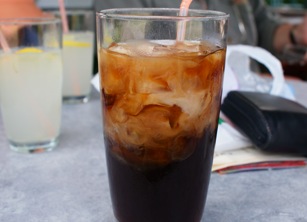Density stratification in which lighter fluid overlies heavier fluid is one of the two canonical features of naturally occurring flows (rotation is the other). Since density differences inside a fluid are typically small (compared the thousand-fold difference in density between air and water) and hence the motions are slow. In the picture on the above left I have taken a glass of iced coffee and poured in milk. Almost everyone knows that when we do this with warm coffee the milk at first forms coherent structures like vortices, but rather quickly the mixing is nearly complete and we get the light brown fluid that drives much of daily life. When the coffee is cold the room temperature milk plunges into the coffee, induces some mixing (note the range of colours in the image) but below a certain level the motions lack the energy to mix the cold coffee any further and a rather sharp transition between milky fluid and black coffee is evident.
In the image on the right a cornstarch laden fluid dyed a light blue with food colouring was poured into clear, room temperature water. The fluid motion was initially quite turbulent with a large cloud of blue water. However, even the small density differences between the corn starch-laden fluid and clear water proved enough to collapse the cloud into the intrusive gravity current (propagating left to right) evident in the image. At the time the image was taken the gravity current has passed over a small hill built in the tank and has reached a patch of salty (hence heavier) water. You can see that the top of the gravity current is quite turbulent with many vortices evident, however the bottom being lifted above the salty water is moving with no trace of turbulence.
Of course stratification can also induce turbulence, like when a fluid is heated below to induce convection. Convection can occur in many different contexts from the lab, to the afternoon atmosphere on a summer day, to the mantle on thousand year time-scales.
Stratified Fluids





